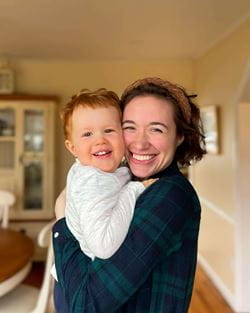It wasn’t until three days after Andrew Cranshaw’s birth in April 2020 that his parents, Megan and Alex, knew anything was wrong with their baby boy. Megan’s pregnancy, her first, had been normal up until the end, when COVID intervened.
“Alex was not permitted to come with me to my last appointments, and it was really stressful,” she says. “It was a lot to navigate.”
 Andrew arrived and looked healthy and happy. Three days later, their pediatrician at home on Long Island, N.Y. called with news that the newborn screening had come back and revealed that Andrew had very long chain acyl-CoA dehydrogenase (VLCAD) deficiency, a genetic disorder in fatty acid oxidation that affects the ability of the body to make energy. The pediatrician told them that they would need to take more blood to confirm the diagnosis and not to search online for more information just yet.
Andrew arrived and looked healthy and happy. Three days later, their pediatrician at home on Long Island, N.Y. called with news that the newborn screening had come back and revealed that Andrew had very long chain acyl-CoA dehydrogenase (VLCAD) deficiency, a genetic disorder in fatty acid oxidation that affects the ability of the body to make energy. The pediatrician told them that they would need to take more blood to confirm the diagnosis and not to search online for more information just yet.
Of course, they did turn to the web.
“What came up was really unsettling,” says Megan. “We couldn’t make sense of it.”
Within a day they saw the pediatrician, who ordered more bloodwork. But since this was the first month of COVID, the labs were closed. Instead, the Cranshaws would have to take Andrew directly to a local hospital that was the epicenter of Long Island’s COVID response.
“He was so tiny they couldn’t find a vein. Everyone around us in the hospital was so stressed and scared.” Megan recalls. Andrew had an appointment with a cardiologist a few days later for an EKG, which records the electrical signal of the heart.
“It was a lot because we didn’t really know what we were dealing with,” Megan says. The Cranshaws were soon connected with the genetics team at their local hospital.
What is VLCAD Deficiency?
Very long-chain acyl-CoA dehydrogenase deficiency (VLCADD) is a rare genetic disorder of fatty acid metabolism that occurs when an enzyme needed to break down certain fatty acids to generate energy during times of stress or fasting is missing or not working properly. VLCAD deficiency occurs in about one in 40,000 babies.
 One of the challenges of being parents of a child with VLCAD deficiency is that there is a lot that is not known about the disorder. In infants, it is especially important to prevent and control low blood sugar, which in a child with VLCAD can lead to breathing problems, seizures, and coma. Other problems can include an enlarged liver, a weak and enlarged heart, and muscle problems.
One of the challenges of being parents of a child with VLCAD deficiency is that there is a lot that is not known about the disorder. In infants, it is especially important to prevent and control low blood sugar, which in a child with VLCAD can lead to breathing problems, seizures, and coma. Other problems can include an enlarged liver, a weak and enlarged heart, and muscle problems.
“I began tracking everything Andrew ate and how often,” says Megan, when he was put on a special formula. Then when he began eating solid foods, they put Andrew on a heart-healthy diet. He couldn’t have certain fats or whole fat dairy products. Alex, who likes to cook, developed a weekly meal plan for Andrew. “We have a very structured daily meal plan now and thankfully Andrew is so good about it all. He’s a really good eater.”
And now at 2-1/2, Andrew is thriving. He gets routine lab tests and sees his metabolic team every three months. He’s never really been sick, aside from a bout with an ear infection as an infant.
“We have been really restrictive with where we go and who we see,” Megan says. “Moving forward, we know this will have to change.”
Coming to Pittsburgh
That’s where the Center for Rare Disease Therapy at UPMC Children’s Hospital of Pittsburgh comes in. Andrew’s parents wanted to get a better understanding of his diagnosis, of what to expect as Andrew gets older. One of their doctors on Long Island knew of Jerry Vockley, MD, PhD, chief of Medical Genetics and Genomics at UPMC Children’s and director of the Center for Rare Disease Therapy. Dr. Vockley is internationally recognized as a leader in the field of inborn errors of metabolism. His lab has been responsible for identifying and characterizing multiple new genetic disorders, many of them defects in mitochondrial energy metabolism, including VLCAD deficiency. Both Megan and her mother also found him on the web while they researched VLCAD.
“We wanted to get the best opinion possible,” says Megan. “We really needed clarity and confidence moving forward so we came to Dr. Vockley for that.”
Typically, the diagnosis of VLCAD deficiency is made by sequencing its gene, but when this test was equivocal, additional evaluation was necessary. The usual next step is for patients to get a skin biopsy so that the VLCAD enzyme can be measured (a test performed in Dr. Vockley’s lab). However, Dr. Vockley was able to explain to the family that a new test he had developed could clarify the diagnosis and possible severity of his disease.
“We simply synthesize the version of VLCAD identified in Andrew and test its function in the lab without the need for a biopsy,” explains Dr. Vockley.
And the test is not available anywhere else in the world. Right now, it’s a wait and see game – it’s possible that the symptoms of his VLCAD deficiency may not surface until Andrew’s preteen or teen years.
 They are also in a continuing conversation with Alyssa Smith, a metabolic dietitian who works with the metabolic group in the division of Genetic and Genomic Medicine. While Andrew is in his bubble now, eventually he will go to school and his parents will have to navigate that new experience of not being able to watch him as carefully. Currently, Megan tracks everything that Andrew takes in.
They are also in a continuing conversation with Alyssa Smith, a metabolic dietitian who works with the metabolic group in the division of Genetic and Genomic Medicine. While Andrew is in his bubble now, eventually he will go to school and his parents will have to navigate that new experience of not being able to watch him as carefully. Currently, Megan tracks everything that Andrew takes in.
“I’m comfortable with what I’m doing right now. I won’t be able to track as closely what he’s eating in school though.” she says. The team at UPMC Children’s will help navigate that transition.
Perception Is Not Reality
Because of the nature of VLCAD deficiency and the sheer number of unknowns that accompany it, the Cranshaws have been very cautious about where they go and who they see.
“If he gets sick and he doesn’t eat, it could put his body in a state where he might have to go to the hospital,” says Megan. “We have been so careful because we don’t want to put him through any unnecessary risk.”
At the same time, one of the big challenges is that Andrew doesn’t look sick. He’s above average in terms of intelligence and cognition.
“You’d never know anything is going on behind the scenes, which is wonderful but also isolating,” Megan says. They tread carefully. “We’re not just being cautious first-time parents,” she laughs. “We try to give him the fullest life possible but also have to navigate a lot of uncertainty.”
 The family has a perfect set-up at home right now. Andrew is with Megan’s parents during the day. Her mom is a retired speech language pathologist and her dad, a retired special education teacher. Megan, Alex, and Andrew have a senior dachshund named Penny, who Andrew loves.
The family has a perfect set-up at home right now. Andrew is with Megan’s parents during the day. Her mom is a retired speech language pathologist and her dad, a retired special education teacher. Megan, Alex, and Andrew have a senior dachshund named Penny, who Andrew loves.
“He likes to pretend he’s Penny’s doctor,” says Megan. He also likes to pretend to be a chef in the kitchen, helping Alex with their meals.
The Cranshaws have learned first-hand that anyone can suddenly be faced with dealing with a rare genetic disorder, and when that happens, information can be hard to find or understand.
When something so specific is afflicting your child, Megan says, “we feel so grateful that Dr. Vockley is only seven hours away. The trip is completely worth it to know that we’re being cared for and guided the best we can be.”
Andrew’s treatment and results may not be representative of all similar cases.









